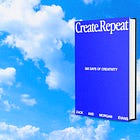The 3 Stages of Mastery
Learn the game. Learn the players. Change the rules.
One of the most common questions I get is: How do you actually succeed in today’s world of algorithms, trends, and content overload?
It’s not the kind of thing I usually write about. Create.Repeat has always been focused on the soul of the creative process. I care more about why we make things than how to beat the system. I want to help people reconnect with the joy of creating for its own sake.
But I also live in the real world.
Like many of you, I need to put food on the table. And if I can do that through my creativity, I’d much rather follow that path than any other. That’s the gift, but also the tension.
So in this letter, I want to talk about winning.
What does it mean to win as a creative person today?
How do you master your craft?
How do you get to a point where you can do what you love and still make it work?
Let’s talk about what it really takes to build a creative career. There is a path. It just might not be the one we were taught to follow.
The most common mistake I see from creatives (myself included!!) is jumping into a new lane and trying to do things their own way from day one. As if they already have all the answers. As if the goal is to prove there’s a better way, without ever understanding the current one.
Now, I don’t think it’s wrong to experiment early on. That’s how you figure out whether you even like something. Play is part of the process. But when you’re serious about succeeding in a field you’re new to, you must approach it with humility, not arrogance.
This applies to everything. Growing an audience on social media. Starting a new role at a job. Pivoting from being a painter to becoming a filmmaker. Whatever new path you’re pursuing, the same process applies.
To truly master something, you have to move through the three stages:
Every industry, every medium, every platform has a game being played.
That game might not be fair. It might be frustrating. It might be built on outdated rules or driven by metrics you don’t care about. But if you’re serious about succeeding, you need to understand it before you try to change it.
Learning the game means watching how things actually work. What gets attention? What gets rewarded? What’s considered good? And why?
You don’t have to like the game. You just need to learn it. Because until you understand the patterns, the incentives, and the standards, you’re creating in the dark.
This is where I see most people tap out. They either reject the system entirely or imitate it blindly. But the people who last, the ones who carve out careers doing meaningful work, are the ones who study it on purpose. They pay attention to the details most people overlook. They reverse engineer the things they love. They don’t just consume, they analyze.
As you work on your craft and move from novice to master, a shift happens. You stop seeing things through the lens of a fan and start noticing the structure behind the magic. The best movie you’ve ever seen, the one that felt like it was made just for you, still followed a three-act structure. The song that brought you to tears still had a bridge and a chorus.
You have to understand the game. Whatever you’re trying to do, take the time to learn how it works and why it’s done that way. There’s a reason for everything. Once you understand that, something unlocks. It feels obvious. You can’t unsee or unlearn it.
You can’t break the rules if you don’t know what they are.
Once you understand how the game works, the next step is learning who’s playing it and how.
Who’s winning right now? Who’s consistently showing up? Who’s taking risks? Who’s being overlooked? The answers to these questions will tell you just as much as the content itself.
This part is about pattern recognition. You’re studying how people operate, what they prioritize, and which choices are creating results. Not so you can copy them, but so you can understand the strategy behind the surface.
Watch what successful people are doing, but also pay attention to what they’re not doing. Who they’re speaking to. What they’re ignoring. What they seem to value. What they’re willing to walk away from. Who their influences are.
Studying the winners can feel like a cheat code, especially when you go back far enough. The deeper you look, the easier it becomes to hear the voice behind the voice.
There’s no Frank Ocean without Stevie Wonder.
There’s no Jim Carrey without Charlie Chaplin.
There’s no LeBron James without Michael Jordan.
Every artist is standing on someone else’s shoulders. The difference is whether you recognize it or not.
Creativity doesn’t happen in a vacuum. It’s a long chain of influence, each link building on the one before it. The greats didn’t appear out of nowhere. They studied the game, studied the players, and then chose which parts to carry forward and which parts to leave behind.
When you start seeing those connections, you begin to realize you’re not as far away as you think. The people you admire were once standing where you are now, looking up at someone else and trying to figure out how to get started.
We all want to be different. We want to innovate. We want to stand out. But lasting originality comes from understanding the rules so deeply you know exactly where they no longer apply.
You can’t reinvent a system you’ve never studied. You can’t lead if you haven’t first followed. The creatives who truly change the game rarely set out to be rebels. They just outgrew the template.
At a certain point, you stop mimicking. You stop obsessing over what’s working for everyone else. You trust your taste. You take risks. You start building the thing you wish existed.
And because you’ve done the work, because you understand the game and the players, those risks are no longer reckless. They are intentional, strategic, and personal.
This is where the shift happens. You are no longer chasing approval. You are building a body of work. One that reflects what you care about. One that resonates with the people who are waiting for something different.
You don’t need to break everything just to prove you’re original. But you do need to know when to bend the rules in a way that only you can.
That is how the game changes. Quietly. Slowly. Then all at once.
Keep creating and repeating,
Zack
✍️ Short Video: “Creativity Is Embarrassing”: A brief visual take on the awkward edges of making.
💭 Website as Thinking Tool: How your personal site can amplify your ideas and creativity.
🛋️ Homes & Studios: A gallery of creative spaces where art, living, and work overlap.
🚣 The Imperfectionist: How to Get Out of a Rut: Thoughts on embracing imperfection to move forward.
Create.Repeat is a community for creatives.
The Create.Repeat Substack is a project designed to be a weekly diary on creativity. Sharing inspiration for artists to keep creating and repeating.
Written and curated by Zack Evans & James Warren Taylor
Each week we will be sharing recent thoughts on creativity, some links helping us stay creative, and a talent show featuring an artist from the community. Thank you for engaging with us.
History repeats. Create the future.












You can’t reinvent a system you’ve never studied!!!! So so so good bro. I'm gonna quote you! And thank you so much for this gem. 🧡🙌🏽🍀🌠
This hit home. It really is like a cheat code, just with a lot more effort! I’ve been thinking about that line between influence and imitation, and how we use that for our own voice. I wrote a short piece on that while showing some of my influences, so this really resonated.
https://jazzcow.substack.com/p/douglas-miles-and-looney-tunes-walk